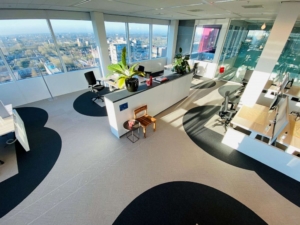
Twitter told its employees they never have to show up at the office again if they can get their job done at home or somewhere else. Facebook has followed suit. Will that be true for a wide swath of other workers? Maybe.
Stay-at-home orders have forced many workers to work remotely, in many cases clawing out “office” space in a spare bedroom or on the dining room table. Despite distractions such as children, television and a nearby wine cabinet, many workers say they have enjoyed the experience, which eliminated time-consuming commuting and allowed more time to interact with family members or take a break in the backyard.

Architects have taken note and developed post-pandemic office schematics. The spaces they envision are smaller overall with more room between workstations and a premium on mobility. They are designs for workers who only pop into the office occasionally and for short stays.
Working remotely was gaining disciples before the coronavirus struck. Coffee shops were chocked full of remote workers sucking down coffee with their laptops plugged into the wall.
What the economic lockdown has wrought is a wider group of remote workers who are learning collectively in real-time how to meet, collaborate and do their jobs using online tools. They also are learning some of the drawbacks – isolation from team members, lack of spontaneity and fewer chances to network. Remote work also can expose bad work habits such as short attention spans, an aversion to self-directed improvement and productivity lulls.
For business owners and managers, remote working situations pose challenges, too. How do you create and maintain a company culture? How do you sustain internal communication? How do you evaluate what everyone is doing? How do you manage work flow on team projects? How do you ensure against cybersecurity breaches? How do you tell if an employee is suffering anxiety or abnormal stress?
Presumably Twitter is satisfied with the individual and group dynamics of its remote workforce. CEO Jack Dorsey had called for distributed work patterns before the pandemic and has used the outbreak to accelerate plans. Twitter says it won’t reopen its physical offices until at least September, has canceled virtually all business travel indefinitely and upped the employee work-at-home supply allowance to $1,000.
Jennifer Christie, Twitter’s human resources director, predicts the technology company would “never probably be the same” in how it structures work. “People who were reticent to work remotely will find that they really thrive that way,” Christie says. “Managers who didn’t think they could manage teams that were remote will have a different perspective. I do think we won’t go back.”
The growing amount of experience with remote work has produced some best practices and practical advice for what may become the new normal.
For remote workers:
- Remote workers should maintain a schedule and stick to a routine, much like they did when trooping to the office everyday. Base the schedule on your best results so you maximize your productivity. Set deadlines that you keep. Keep workmates and clients up to date on your progress.
- Teams working remotely should coordinate through a tracking tool and joint calendar. Select tools that fit your work patterns and your employees will use. Make sure everyone on the remote team knows their assignments and the deadlines to complete them.
- Remote work doesn’t necessarily mean nomadic worksites. Find a place or places where you can concentrate and be comfortable working. Keep your “desk” organized, decluttered and mobile. Find a convenient and safe place to store critical information such as passwords and access codes. Use secure internet for critical information exchanges. Beware of malware.
- Working remotely doesn’t obviate the need to take breaks. Set clear boundaries when working at home, but welcome family or pet distractions as opportunities. Take a walk. Make personal calls. Do Yoga stretches.
For company owners and managers:
- Managers should take full advantage of Zoom or Team video chats. Insist on crisp, action-oriented agendas. Exchange information efficiently. Be gracious and patient with interruptions, such as dogs barking or children photo-bombing a session. Schedule and maximize regular in-person get-togethers.
- Company owners and managers need to lay down clear expectations for remote workers. Declare remote working environments are an intentional choice, not a special privilege. Insist on consistent, informative internal communications. Find ways to underscore corporate culture. Ask staff members, in the office or working remotely, for feedback and fresh ideas. Be open to new tools and techniques that enhance remote work. Manage expectations for in-person and remote working staff, strengthen the sense of team and stay alert to potential antagonism between office-bound and free-roaming workers. Avoid any temptation to employ surveillance.

Gary Conkling is principal and co-founder of CFM Strategic Communications, and he leads the firm’s PR practice, specializing in crisis communications. He is a former journalist, who later worked on Capitol Hill and represented a major Oregon company. But most importantly, he’s a die-hard Ducks fan. You can reach Gary at garyc@cfmpdx.com and you can follow him on Twitter at @GaryConkling.



